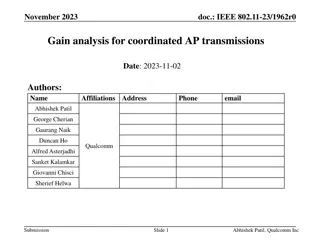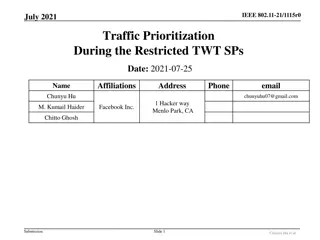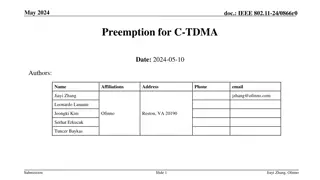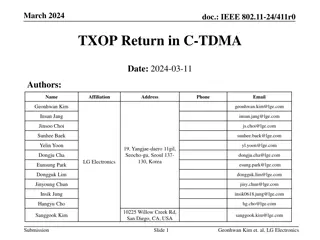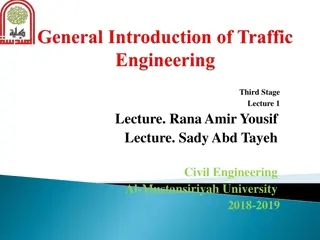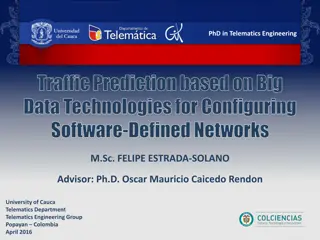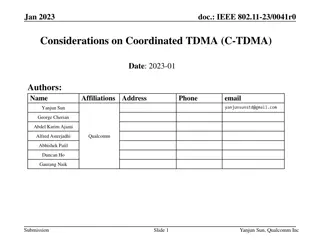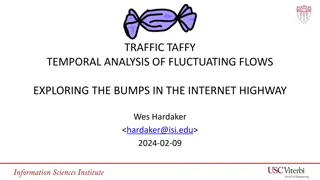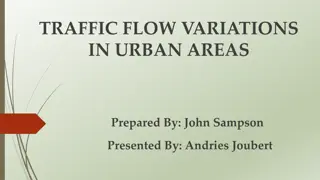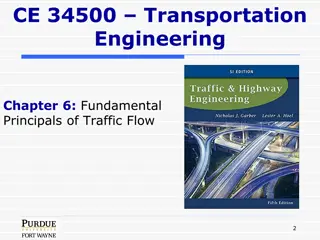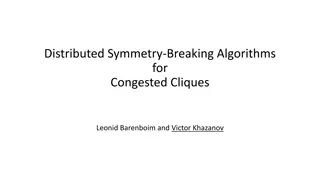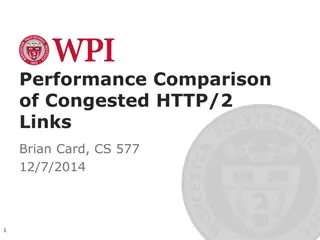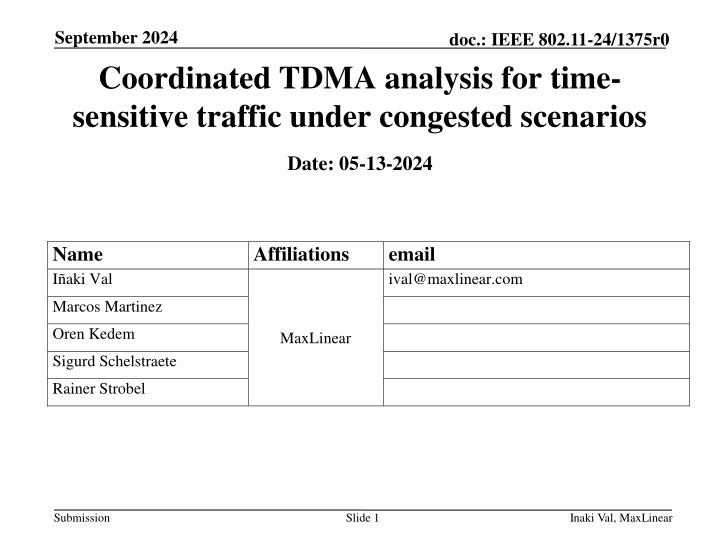
Coordinated TDMA Analysis for Time-Sensitive Traffic in Congested Scenarios
Explore the September 2024 document on IEEE 802.11-24/1375r0 focusing on the performance evaluation of C-TDMA under congested scenarios. Understand the goals, introduction, motivation, and the recap of C-TDMA mechanism for time-sensitive services in wireless networks.
Download Presentation

Please find below an Image/Link to download the presentation.
The content on the website is provided AS IS for your information and personal use only. It may not be sold, licensed, or shared on other websites without obtaining consent from the author. If you encounter any issues during the download, it is possible that the publisher has removed the file from their server.
You are allowed to download the files provided on this website for personal or commercial use, subject to the condition that they are used lawfully. All files are the property of their respective owners.
The content on the website is provided AS IS for your information and personal use only. It may not be sold, licensed, or shared on other websites without obtaining consent from the author.
E N D
Presentation Transcript
September 2024 Coordinated TDMA analysis for time- sensitive traffic under congested scenarios doc.: IEEE 802.11-24/1375r0 Date: 05-13-2024 Name I aki Val Affiliations email ival@maxlinear.com Marcos Martinez Oren Kedem MaxLinear Sigurd Schelstraete Rainer Strobel Submission Slide 1 Inaki Val, MaxLinear
September 2024 doc.: IEEE 802.11-24/1375r0 Goals Performance evaluation of C-TDMA under congested scenarios, including OBSS/ESS and repeater deployments, focusing on time-sensitive services Establishment of realistic simulation frameworks including modeling of high-level transport protocols Submission Slide 2 Inaki Val, MaxLinear
September 2024 doc.: IEEE 802.11-24/1375r0 Introduction 802.11bn targets the improvement of packet delivery by reducing the transmission latency and enhancing network reliability [1] Applications and use cases with QoS-related requirements (e.g., bounded latency and reliability) have been growing in recent times [2] The critical QoS services can be mainly characterized by periodic traffic patterns, and strict timing requirements for data exchange [2, 3] Relying on enhancing throughput is not tenable in the long term as a sole requirement for correct QoS service operation, especially under heavily congested scenarios Submission Slide 3 Inaki Val, MaxLinear
September 2024 doc.: IEEE 802.11-24/1375r0 Motivation The wireless scenarios are getting more congested due to the increase of connected 802.11 devices, competing for the wireless medium in the same primary channel. It has been shown that as congestion increases, and under contention-based congestion management, aggregated throughput gets saturated, and the latency is highly affected [4, 5, 6]. On the other hand, many services run over transport protocols such as TCP, whose functionality depends on the RTT (Round Trip Time) latency performance, degrading the throughput while the latency increases. Coordinated TDMA mechanism under Multi-AP framework [7, 8] may improve the predictability of those time-sensitive services, helping to redistribute the time resources. Submission Slide 4 Inaki Val, MaxLinear
September 2024 doc.: IEEE 802.11-24/1375r0 C-TDMA: Recap Shared TXOP Shared TXOP TXS RTS TF CTS AP BSS1 BSS1 TXOP Time BSS1 TXOP AP BSS2 Time BSS2 TXOP BSS2 TXOP CTS TXS RTS TF Other AP BSSs Time TXOP TXOP Coordinated TDMA allows cooperation of two APs, by sharing the gained TXOP between them Both BSSs take advantage of the gained time, reducing the waiting time to access the channel, and hence the latency of the different traffic flows, especially for those that have higher priority access category Submission Slide 5 Inaki Val, MaxLinear
September 2024 doc.: IEEE 802.11-24/1375r0 C-TDMA: Latency Reduction BSS1 Access Interval AP BSS1 Uncoordinated BSS1 TXOP BSS1 TXOP Time AP BSS2 Time BSS2 TXOP Other AP and non-AP STAs Time TXOP TXOP Heavily Congested C-TDMA does not change the time used per BSS, it redistributes the assigned time to the coordinated APs, getting an improvement in latency, by reducing the access time for the shared AP BSS1 Access Interval BSS1 Access Interval Shared TXOP Shared TXOP Shared TXOP TXS RTS TF TXS RTS TF CTS AP BSS1 C-TDMA BSS1 TXOP BSS1 TXOP BSS1 TXOP Time BSS2 TXOP BSS2 TXOP BSS2 TXOP AP BSS2 Time CTS CTS TXS RTS TF Other AP and non-AP STAs Time TXOP TXOP Heavily Congested Submission Slide 6 Inaki Val, MaxLinear
May 2024 doc.: IEEE 802.11-24/1375r0 Simulation Setup We identify two scenarios where the C- TDMA mechanism can be deployed OBSS scenario: coordination between at least one pair of independent neighboring BSSs sharing the same channel Repeater (ESS) scenario: coordination between two in-home AP devices from the same network (ESS), and sharing the same channel. Submission Slide 7 Inaki Val, MaxLinear
September 2024 doc.: IEEE 802.11-24/1375r0 OBSS Simulation Setup Apartment 3 Apartment 4 Four independent BSSs, each one per apartment, each BSS is composed of one AP and 5 non-AP STAs All STAs are in ED range Next step will include [PD, ED] range Three possible coordination scenarios Uncoordinated (Baseline) BSS1/BSS2 coordinated BSS1/BSS2 and BSS3/BSS4 coordinated PHY/MAC configuration for Data frames SU 80 MHz/1SS/MCS:11 for creating overloading/saturation situation SU 160 MHz/2SS/MCS:11 for creating underloading situation Note: underload and overload situation is a combination of PHY settings, scheduling, data traffic, network topology and AC settings. BSS4 BSS3 BSS1 BSS2 Apartment 2 Apartment 1 Submission Slide 8 Inaki Val, MaxLinear
September 2024 doc.: IEEE 802.11-24/1375r0 Repeater Simulation Setup ESS is composed of a Gateway (GW) and Repeater (R) devices, connected through a wireless backhaul The Repeater is composed of a non-AP STA and AP devices, internally bridged using the same radio Each AP has 5 associated STAs The STAs All are in ED range Even if in ED range, Repeater associated STAs may have poor link with the Gateway Next step will include [PD, ED] range Two possible coordination scenarios: uncoordinated and GW/R coordinated (both do C-TDMA) PHY/MAC configuration for Data frames SU 80 MHz/1SS/MCS:11 for creating overloading situation 802.11 Backhaul GW R Submission Slide 9 Inaki Val, MaxLinear
September 2024 doc.: IEEE 802.11-24/1375r0 Traffic Generation (OBSS Case) Each BSS has the following data services: STA1 Service: Video conference (DL/UL 3 Mbps, 250B length) [UDP, VI_AC] STA2 Service: Video streaming 4K UHD H264 (DL 32 Mbps, 1500B length) [closed-loop TCP, VI_AC] STA3 Service: Gaming (DL/UL 140kbps, Periodicity 7 ms, 110B length) [UDP, VO_AC] STA4 Service: Cloud file sync (DL/UL 10 Mbps, 1500B length) [closed-loop TCP, BE_AC] STA5 Service: Camera (UL 2 Mbps, 1450B length) [UDP, VI_AC] TCP generates TCP-ACK traffic (small length frames) All the STAs generate UL traffic (using TB and EDCA mechanisms) Submission Slide 10 Inaki Val, MaxLinear
September 2024 doc.: IEEE 802.11-24/1375r0 Traffic Generation (Repeater Case) Gateway associated STAs: STA1 Service: Video conference (DL/UL 3 Mbps, 250B length) [UDP, VI_AC] STA2 Service: Video streaming 4K UHD H264 (DL 32 Mbps) [closed-loop TCP, VI_AC] STA3 Service: Gaming (DL/UL 140kbps, Periodicity 7 ms, 110B length) [UDP, VO_AC] STA4 Service: Service 4: Cloud file sync (DL/UL 10 Mbps) [closed-loop TCP, BE_AC] STA5 Service: Camera (UL 2 Mbps, 1450B length) [UDP, VI_AC] Repeater associated STAs: STA6 Service: Video conference (DL/UL 3 Mbps, 250B length) [UDP, VI_AC] STA7 Service: Video streaming 4K UHD H264 (DL 32 Mbps) [closed-loop TCP, VI_AC] STA8 Service: Video streaming 4K UHD H264 (DL 32 Mbps) [closed-loop TCP, VI_AC] STA9 Service: Gaming (DL/UL 140kbps, Periodicity 7 ms, 110B length) [UDP, VO_AC] STA10 Service: Camera (UL 2 Mbps, 1450B length) [UDP, VI_AC] Backhaul link: STA6-10 services All the STAs generate UL traffic (using TB and EDCA mechanisms) Submission Slide 11 Inaki Val, MaxLinear
September 2024 doc.: IEEE 802.11-24/1375r0 C-TDMA Strategies We distinguish two different approaches to decide the shared TXOP length Strategy 1: Share the remaining TXOP length, after the sharing AP local buffers are empty (for the gained and higher ACs) Strategy 2: Pre-negotiated soft time threshold between the two coordinated APs The sharing AP may start sharing the TXOP before the time threshold if it has no more data, for the gained and higher ACs, in its BSS (Case A) The sharing AP may delay sharing the TXOP if there is an ongoing data exchange that exceeds the time threshold (Case B) It defines a flexible maximum time length that the sharing AP can use for transferring data, established by an external arbiter, while the rest will be used by the shared AP Both strategies end the TXOP after the shared AP finishes It can be a premature termination sending CF-End frame Next step simulations will include dynamic TXOP sharing ratio calculation S2: Case A S2: Case B BSS1 No Data Time Time BSS1 No Data Threshold Threshold Last AP BSS1 C-TDMA exchange finished BSS2 No Data BSS1 TXOP (Sharing) BSS1 TXOP (Shared) Time BSS2 TXOP (Sharing) AP BSS2 BSS2 TXOP (Shared) TXOP TXOP Submission Slide 12 Inaki Val, MaxLinear
September 2024 doc.: IEEE 802.11-24/1375r0 OBSS Overall Network Results Network underloaded situation Network overloaded/saturated situation For both network situations, while C-TDMA is set up the Strategy 2 using a time threshold of 50% (over the total gained TXOP length), it can be observed a trend for overall network latency (P95) reduction, including the total number of collisions in the air, increasing the air usage efficiency. Submission Slide 13 Inaki Val, MaxLinear
September 2024 doc.: IEEE 802.11-24/1375r0 OBSS - Gaming Results Network underloaded situation Network overloaded/saturated situation For both network situations, it can be observed that when BSS1/BSS2 use C-TDMA, the latency is reduced by 20-30%, while the uncoordinated BSSs (BSS3/BSS4) are not affected by unfairness. The same latency gain is obtained when both BSS pairs coordinate their transmissions. Submission Slide 14 Inaki Val, MaxLinear
September 2024 doc.: IEEE 802.11-24/1375r0 OBSS Video Conference Results Network underloaded situation Network overloaded/saturated situation In a very similar trend, the video conference latency results show an improvement in the RTT latency by 40-60% respect the uncoordinated setup Submission Slide 15 Inaki Val, MaxLinear
September 2024 doc.: IEEE 802.11-24/1375r0 OBSS Video Streaming Results Network underloaded situation Network overloaded/saturated situation The use of C-TDMA improves the throughput performance for Video Streaming, as TCP is sensitive to latency performance, obtaining a gain in the range 10-20% Submission Slide 16 Inaki Val, MaxLinear
September 2024 doc.: IEEE 802.11-24/1375r0 Repeater/Mesh Simulation Results Five different coordination setups No coordination between GW and Repeater (baseline) C-TDMA Strategy 1 C-TDMA Strategy 2 Having a sharing threshold of 50/50: 50% of TXOP length for the GW, and 50% length for the Repeater Having a sharing threshold of 60/40: 60% of TXOP length for the GW, and 40% length for the Repeater Having a sharing threshold of 70/30: 70% of TXOP length for the GW, and 30% length for the Repeater No improvement for Strategy 1, few opportunities for sharing the TXOP, and having additional overhead, the network latency gets worse respect the uncoordinated setup. Best improvements for sharing thresholds of 50/50 and 60/40, improving the data flow along the Repeater. Reducing the shared TXOP length on the Repeater side increases the latency, having less time to schedule its associated STAs. Even if the traffic load is higher in the GW side, the number of associated STAs in both sides is the same. Submission Slide 17 Inaki Val, MaxLinear
September 2024 doc.: IEEE 802.11-24/1375r0 Repeater/Mesh Gaming/Video Conference Results The gaming latency improves in the Repeater side for both C-TDMA strategies. As the traffic load for gaming is low, the gained VO_AC TXOP has enough length for sharing in both BSSs. For C-TDMA S2, video conference latency is improved by 65%, as the coordination enhances the data flow between the GW and Repeater The GW side performance shows no variation, the main contribution of C-TDMA is the improvement on the Repeater side Submission Slide 18 Inaki Val, MaxLinear
September 2024 doc.: IEEE 802.11-24/1375r0 Repeater/Mesh Video Streaming Results The use of C-TDMA S2 improves the latency in video streaming service, and consequently the throughput is improved, as TCP is sensitive to the RTT latency. Again, the GW side performance shows no variation, the main contribution of C-TDMA is the improvement on the Repeater side Submission Slide 19 Inaki Val, MaxLinear
September 2024 doc.: IEEE 802.11-24/1375r0 Summary C-TDMA improves the performance in those latency-sensitive flows/services already configured with their corresponding high-priority ACs, otherwise the improvement is limited. C-TDMA redistributes the time resources, giving more chances to specific already protected services, but does not create additional resources C-TDMA provides better chances to give the channel to another BSS, especially in those highly congested scenarios with many contending STAs Coordinated APs need to generate the same number of TXOPs, with the same priority, to have balanced cooperation, otherwise only one network will take advantage of C-TDMA Next steps will include scenarios of unbalanced networks Most advantages of C-TDMA can be seen in repeater scenarios, improving the performance in terms of throughput and RTT latency of the Repeater network for the protected services Submission Slide 20 Inaki Val, MaxLinear
September 2024 doc.: IEEE 802.11-24/1375r0 Conclusion We have presented simulation results for Coordinated TDMA mechanism, focusing on the performance improvement of the latency sensitive services. We have covered the highly congested scenario under an OBSS environment, and the repeater scenario. In both cases, we have showed how C-TDMA can increase the number transmission opportunities for those services configured with high priority AC, which under congestion conditions may have limited advantage. In the repeater case, the coordination between the two APs improves the data flow through the wireless backhaul. Submission Slide 21 Inaki Val, MaxLinear
September 2024 doc.: IEEE 802.11-24/1375r0 References [1] IEEE 802.11-23/0028r6, UHR PAR discussion [2] Inaki Val and et al. (MaxLinear), High Criticality Use Cases and Requirements , 23/1522r0 [3] Oliver Holland and et al. Low Latency Communication White Paper , P802.24-23- 0010r4 [4] Salvatore Talarico and et al. (Sony), Enhanced HCCA for Controlled UHR Scenarios , 24/0119r0 [5] Yanchun Li and et al. (Huawei), Discussion on UHR enhanced channel access , 23/1973r1 [6] Inaki Val and et al. (MaxLinear), Managed Networks under highly congested scenarios - Follow up , 24/0405r1 [7] Abhishek Patil and et al. (Qualcomm), Coordinated TDMA (C-TDMA) Follow-up , 23/1895r2 [8] Geonhwan Kim and et al. (LG Electronics), Coordinated TDMA Procedure , 23/1912r1 Submission Slide 22 Inaki Val, MaxLinear

